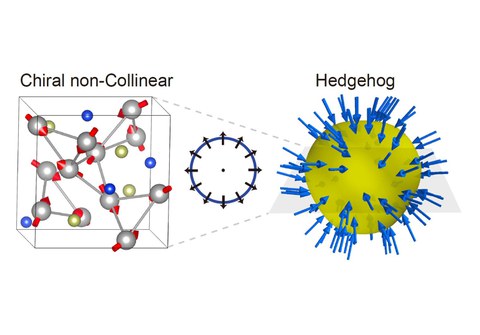13.10.2025
Research: Spin Hall and Edelstein effects in chiral non-collinear altermagnets

The chiral non-collinear structure of Mn3IrSi (left panel), and its hedgehog spin texture (right panel).
Altermagnets (AMs) are a newly discovered class of magnetic materials. They have immediately gained broad interest for their spin-polarized band structure -- previously believed to be exclusive to ferromagnets -- while simultaneously maintaining net-zero magnetization like antiferromagnets. Due to this particular feature, AMs are able to respond to various external stimuli, such as electric fields and strain, without the energy cost from stray fields associated to ferromagnets.
Initially proposed in collinear magnetic systems, where different spins are either parallel or anti-parallel to each other, researchers from Dresden and Sherbrooke have now extended this concept to non-collinear magnets, where the angle between the spins can take more general values. Starting with the phenomenological Landau theory, they first identified a special monopolar order parameter, which is coupled to the real-space chiral and non-collinear magnetic structure. This order parameter gives rise to a hedgehog spin texture in momentum space, which is further confirmed by both a toy model and first-principles calculations on Mn3IrSi.
As a microscopic mechanism, the researchers found that the hedgehog spin texture guarantees large spin Hall and Edelstein effects compared to conventional non-magnetic systems. By applying their theory to more candidates, the research team believe that chiral non-collinear AMs can be promising platforms for future spintronic applications.
M. Hu, O. Janson, C. Felser, P. McClarty, J. van den Brink, M. G. Vergniory,
Spin Hall and Edelstein effects in chiral non-collinear altermagnets,
Nat. Commun. 16, 8529 (2025) (arXiv)
